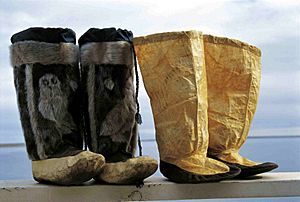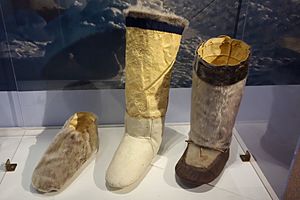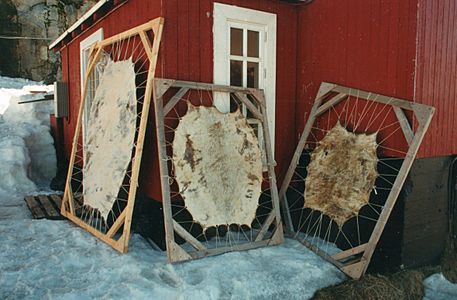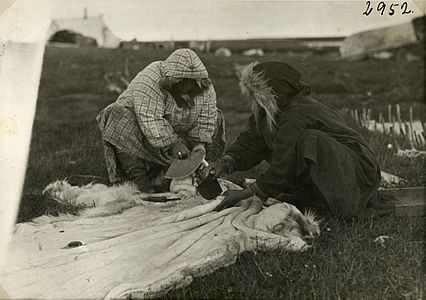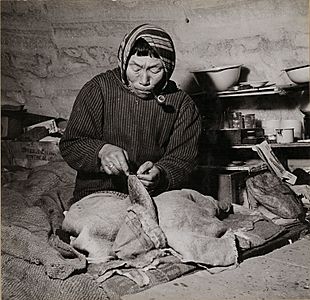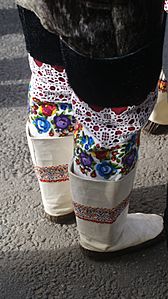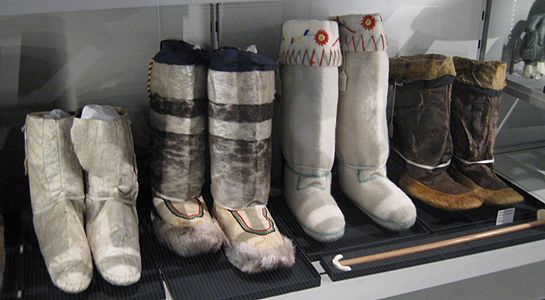Mukluk facts for kids
Mukluks or kamik are special soft boots. People who live in the Arctic region have traditionally worn them for a long time. These boots are usually made from reindeer (also called caribou) skin or sealskin. Groups like the Inuit, Iñupiat, and Yupik people wear them.
The word mukluk comes from the Yupik language. It means "bearded seal," which is a type of seal. The word kamik comes from the Inuit language.
People often wear mukluks with an inner boot liner and sometimes an overshoe for extra protection. Today, the term "mukluk" can mean any soft boot made for cold weather. Modern mukluks can use both traditional and new materials.
Contents
What are other types of boots like mukluks?
Many soft-soled boots are worn in cold areas around the world. These boots are similar to mukluks in how they are made and what they look like. They are often made from sealskin and caribou-skin.
You can find these types of boots in places like:
- The North American Arctic, including Greenland.
- The European Arctic, like Fennoscandia.
- Siberia in Asia.
Inuit boots
Another type of boot, sometimes called an Inuit boot, comes from Greenland and eastern Alaska. These boots are made by tying them together with animal cartilage. They have a seam that runs down the middle to the foot part of the boot.
Slipper socks
There are also "slipper socks" which have a soft leather sole. The top part of these socks is knitted from wool or a wool-rayon mix. People in the Hindu Kush Mountains traditionally wear these.
Why are mukluks useful?
Mukluks have soft soles that bend easily with your feet. This helps hunters move very quietly. People wearing mukluks can run, tip-toe, and even dance! They are also designed to work well in the wide-open, flat lands of the tundra.
Mukluks are also very light. For example, some heavy-duty winter boots can weigh about 8 pounds (around 3.6 kg). But soft-soled boots made with modern materials weigh much less, sometimes less than a tenth of that. Lighter shoes make it easier to run and move around.
How to care for mukluks?

Just like other fur clothes, kamiks are often stored in a cool, unheated room. If they are kept in a warm, dry house, the fur can get damaged quickly. On sunny days, people air them outside, especially in the spring.
After being stored for a season, traditional skin kamiks can become stiff. They need to be worked and stretched to make them soft and flexible again.
It's important to let traditional boots dry completely between uses. This stops them from rotting and helps them last longer. People often have several pairs of boots so they can wear them in a rotation, giving each pair time to dry.
How are mukluks designed?
Mukluks are very light, so they don't need heavy laces to stay on your feet. The friction from the boot is usually enough. Some mukluks have light laces that go through loops sewn into the seams. This prevents leaks. The laces might go over the arch of the foot or around the top of the boot to make it stiffer.
Many mukluks do not have laces at all. This is to avoid squeezing the blood flow and making the feet cold. The top part of the boot stands up somewhat stiffly. It might be open at the top, which lets moisture escape.
Mukluks often have a special "wrapped sole." This means the seam around the sole is on the top and sides of the boot, not on the bottom edge. This design helps prevent the seams from wearing out and leaking.
Different designs for different weather
Kamiks made for cold, dry winter weather might have fur on the outside near the bottom. These features work well on dry, powdery snow. Kamiks for warmer, slushy, muddy, or open-ocean conditions are sewn very carefully from waterproof sealskin.
The short overshoes worn with mukluks can also be waterproof for wet conditions. Or they can be furry and grippy for dry conditions. The inner boots often have the fur facing inwards. People wear them without socks because socks can absorb and hold sweat, which can make feet cold.
Mukluks are often decorated with pompons, beads, embroidery, and other beautiful designs.
The special design of mukluks is used to make some modern cold-weather boots. A key part of the mukluk's success is that it can "breathe." This means it allows air to move in and out. This is very helpful in extremely cold places where sweat can cause frostbite on your feet. However, mukluks are bulky and don't work well in slushy water. They keep snow out, but water can soak through them. This makes them less ideal for everyday winter wear if you're not in a very dry, cold environment.
How are mukluks made?
-
Drying sealskins near Barter Island, Alaska, in June 1914.
-
An Inuit woman named Josie chewing sealskin to soften it for making boots in Kinngait, Nunavut, July 1951.
-
People making waterproof summer overshoes in a tent, around 1900, in Port Clarence, Alaska.
The top part of summer kamik boots is usually made from ringed seal skin. The soles, which need to be tougher, are made from bearded seal skin. Winter kamik are often made from caribou leg fur. Caribou rely on their fur for warmth, so their fur is very good at insulating.
Preparing the animal skin is a lot of work. First, seals must be skinned. Then, the skins are cleaned of blubber, washed with soap, and scraped. After that, they are hung to drain and stretched to dry outside. Sometimes, the skins are bleached in the sun. For summer kamik, the fur is usually scraped off completely. This allows for very tight, waterproof stitching.
A special type of stitching called "blind-stitching" is used. This means the needle does not go all the way through the skin. This, along with using sinew (a natural fiber that shrinks when wet), helps keep mukluks waterproof. If you buy modern boots, you might need to add a special "seam-sealing" product to make them fully waterproof.
For extra warmth, mukluks can be lined with furs from animals like caribou, rabbit, fox, and raccoon. Sometimes, commercial sheepskin is used to line and sole the boots. Other materials like down, polyester, and a type of foam called EVA foam are also used in soft-soled boots. The inner boot can also be made from fabric or wool felt.
Gallery
See also
 In Spanish: Mukluk para niños
In Spanish: Mukluk para niños


